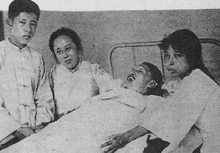He Xiangning
He Xiangning | |
|---|---|
何香凝 | |
 He Xiangning as pictured in The Most Recent Biographies of Chinese Dignitaries | |
| Vice Chairperson of the Chinese People's Political Consultative Conference | |
| In office February 1956 – 1 September 1972 | |
| Chairman | Zhou Enlai |
| Vice Chairperson of the National People's Congress | |
| In office April 1959 – 1 September 1972 | |
| Chairman | Zhu De |
| Chairwoman of Revolutionary Committee of the Chinese Kuomintang | |
| In office August 1960 – 1 September 1972 | |
| Preceded by | Li Jishen |
| Succeeded by | Zhu Yunshan |
| Personal details | |
| Born | 27 June 1878 British Hong Kong |
| Died | 1 September 1972 (aged 94) Beijing |
| Nationality | Chinese |
| Political party | Revolutionary Committee of the Chinese Kuomintang |
| Spouse | Liao Zhongkai |
| Children | Liao Chengzhi |
| Signature | |

He Xiangning (
In 1948, she cofounded the Revolutionary Committee of the Chinese Kuomintang. She served in many high-ranking positions after the foundation of the People's Republic of China, including Vice Chairwoman of the CPPCC (1954–64), Vice Chairwoman of the National People's Congress (1959–72), Chairwoman of the Revolutionary Committee of the Chinese Kuomintang (1960–72), and Honorary Chairwoman of the All-China Women's Federation.
He Xiangning was a renowned painter of the Lingnan School of Chinese art and served as Chairwoman of the China Artists Association in the 1960s. The National He Xiangning Art Museum was opened in Shenzhen in 1997, and her paintings have been featured on Chinese stamps.
Early life
On 27 June 1878,
A determined feminist since she was young,
Revolution

While in Tokyo, He and Liao met the Chinese revolutionary Sun Yat-sen in 1903. They became two of the earliest members of Sun's anti-Qing revolutionary movement Tongmenghui, and Huang Xing taught them to use guns in preparation for revolution. She rented a house as a front for Tongmenghui's secret operations.[1]
After returning to Hong Kong to give birth to her daughter, Liao Mengxing, she left the girl with her family, and went back to Tokyo. She studied painting at Tokyo Women's Arts School[3] with the imperial artist Tanaka Raishō (田中頼章), and assisted in Tongmenghui's propaganda work, including designing and sewing revolutionary flags and emblems. In 1908, she gave birth to her son, Liao Chengzhi.[1]
She and Liao Zhongkai went back to Hong Kong in 1911,
Sun Yat-sen government
In 1916, He Xiangning and her husband moved to Shanghai to advance the revolutionary cause. In 1921, Sun Yat-sen established his revolutionary government in Guangdong, and appointed Liao as his finance minister. He Xiangning persuaded the commanders of seven naval warships to join Sun's government. In Guangzhou, she and Soong Ching-ling organized a women's association to raise funds and provide medicine and clothing for the soldiers. She also sold many of her paintings for the war effort.[1] When General Chen Jiongming rebelled against Sun in 1922, He Xiangning arranged for Sun's reunion with his wife, and took great risk to win the release of her husband, who had been held by the rebels.[1]
In August 1923, she was appointed a member of the Kuomintang (KMT) Central Executive Committee, and Minister for Women's Affairs in Sun's government.[3] She proposed the "complete equality of women with regard to legal, social, economic, and educational rights", and organized China's first rally for International Women's Day on 8 March 1924.[1] She also opened hospitals and schools for women in Guangzhou.[1]
Assassination of Liao Zhongkai and wartime career

After Sun Yat-sen died in March 1925, the left and right wings of the KMT competed for the party leadership. Liao Zhongkai, the leader of the left wing, was assassinated in Guangzhou in August.[3] He Xiangning was beside him at the time, her clothes soaked with his blood.[2]
She returned to Shanghai after the
People's Republic of China

In 1948, during the
He Xiangning kept working until she turned 80 in 1959, and continued to hold many official positions afterwards. On 1 September 1972,[6] she died of pneumonia at the age of 94. She was buried in the Liao Zhongkai Mausoleum in Nanjing, alongside her husband.[1]
Art
A renowned painter of the Lingnan School of Chinese art,[1][3] He Xiangning was elected the third chairperson of the China Artists Association in July 1960.[7] She particularly enjoyed painting plum blossoms, pine trees, tigers, and lions. A collection of her paintings was published in 1979 in Guangdong.[3] On 18 April 1997, He Xiangning Art Museum was opened in Shenzhen. It was China's first national-level art museum named after an individual artist, and Communist Party general secretary Jiang Zemin wrote the calligraphy for the museum's name.[8] In June 1998, China Post issued a set of three stamps (1998-15T) featuring her paintings.[9]
Family
He Xiangning and Liao Zhongkai had two children. Their daughter,
References
- ^ ISBN 978-0-7656-0798-0.
- ^ a b c Ming Xin (2014). 廖承志和他的母亲何香凝 [Liao Chengzhi and his mother He Xiangning]. National People's Congress of China (in Chinese) (15): 51–53. Archived from the original on 2016-03-05. Retrieved 2016-02-27.
- ^ ISBN 978-1-4766-0298-1.
- ^ ISBN 978-1-57607-101-4.
- ISBN 9781315499246.
- ^ 1972年9月1日 民革中央主席、画家何香凝病逝. People's Daily (in Chinese). Archived from the original on 27 October 2018. Retrieved 27 February 2016.
- ^ 中国美协简介 (in Chinese). China Artists Association. Archived from the original on 11 April 2016. Retrieved 27 February 2016.
- ^ "Introduction" (in Chinese). He Xiangning Art Museum. Archived from the original on 2 March 2016. Retrieved 27 February 2016.
- ^ "1998-15 《何香凝国画作品》特种邮票" (in Chinese). China Stamps. Archived from the original on 2 May 2019. Retrieved 27 February 2016.
External links
- Paintings by He Xiangning at He Xiangning Art Museum
- Life of He Xiangning (in Chinese)
